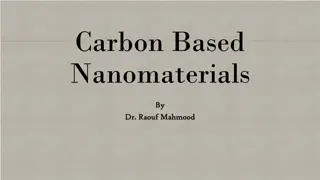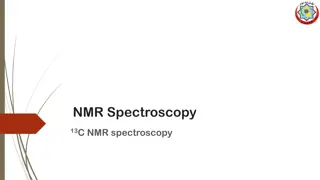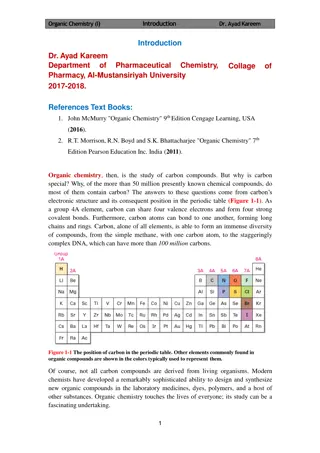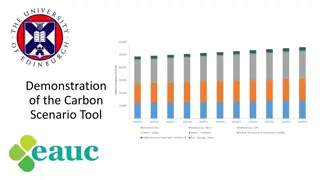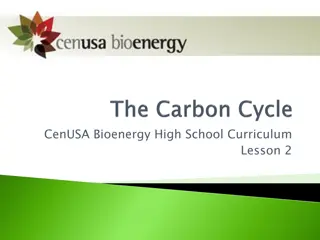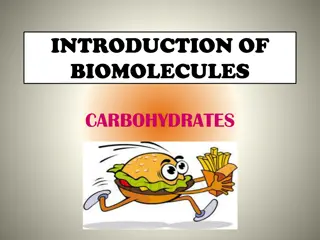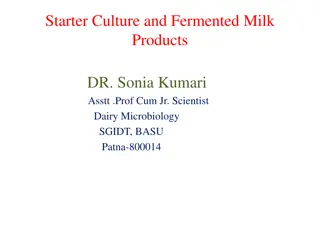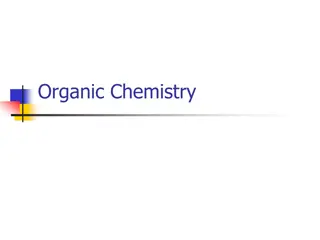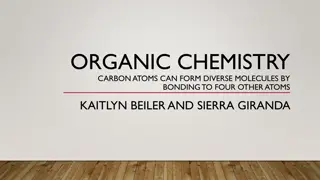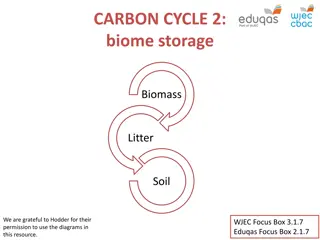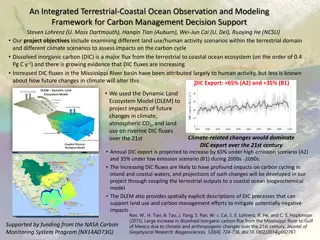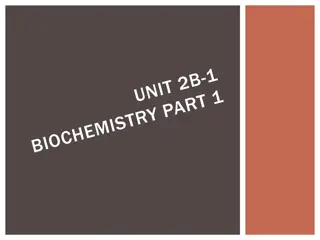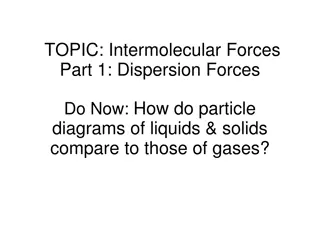Carbon Compounds and Molecules of Life
This content explores the significance of carbon compounds in biological molecules, distinguishing between organic and inorganic compounds, understanding carbon bonding, identifying functional groups, synthesizing large carbon molecules, and the energy currency through ATP in driving chemical reactions.
Download Presentation

Please find below an Image/Link to download the presentation.
The content on the website is provided AS IS for your information and personal use only. It may not be sold, licensed, or shared on other websites without obtaining consent from the author.If you encounter any issues during the download, it is possible that the publisher has removed the file from their server.
You are allowed to download the files provided on this website for personal or commercial use, subject to the condition that they are used lawfully. All files are the property of their respective owners.
The content on the website is provided AS IS for your information and personal use only. It may not be sold, licensed, or shared on other websites without obtaining consent from the author.
E N D
Presentation Transcript
Section 1 Carbon Compounds Section 2 Molecules of Life
Objectives Distinguish between organic and inorganic compounds. Explain the importance of carbon bonding in biological molecules. Identify functional groups in biological molecules. Summarize how large carbon molecules are synthesized and broken down. Describe how the breaking down of ATP supplies energy to drive chemical reactions.
Carbon Bonding Organic Compounds are made primarily of carbon atoms. Most matter in living things is organic Inorganic Compounds do not contain carbon atoms. Water is an example of an inorganic molecule Carbon has four electrons in its outermost energy level. Therefore it can form four bonds Carbon readily binds with other carbon atoms Can form single, double, or triple bonds Can form straight chains, branched chains, or rings.
Functional Groups A cluster of atoms in many organic compounds is called a functional group They influence the characteristics of the molecules they compose and the chemical reactions the molecules undergo. Hydroxyl is a functional group that can make a molecule polar. Polar molecules are hydrophilic and therefore soluble in water
Large Carbon Molecules Monomers are the building blocks of molecules. Polymers consist of repeated linked units Large polymers are called macromolecules Monomers combine to form polymers in a condensation reaction. Water is used to break polymers down in a hydrolysis reaction
Energy Currency Energy is available to the cells in the form of certain compounds that store a large amount of energy in their overall structure. Adenosine Triphosphate (ATP). 5 carbon sugar, ribose Nitrogen containing compound, adenine Three phosphate groups
ATP The phosphate groups are attached to each other by covalent bonds. Relatively unstable bonds When the bond between the phosphate group is broken energy is released. This hydrolysis of ATP is used by the cell to provide the energy needed to drive the chemical reactions that enable an organism to function.
Review Questions (Complete on a separate sheet a paper. Be sure to include your name and period number.) How do inorganic and organic molecules differ? How do carbon s bonding properties contribute to the existence of a wide variety of biological molecules? Name four types of functional groups. What role do functional groups play in the molecules in which they are found? How are monomers, polymers, and macromolecules related to each other? How is a polymer broken down? Why is ATP referred to as the energy currency in living things? 1. 2. 3. 4. 5. 6. 7.
Objectives Distinguish between monosaccharides, disaccharides, and polysaccharides. Explain the relationship between amino acids and protein structure. Describe the induced fit model of enzyme action. Compare the structure and function of each of the different types of lipids. Compare the nucleic acids DNA and RNA.
Carbohydrates Carbohydrates are organic macromolecules that are made up of carbon, hydrogen, and oxygen atoms. These atoms are combined in a ratio of: 1 carbon atom : 2 hydrogen atoms : 1 oxygen atom Some carbohydrates function in storing energy and some provide structural support. Carbohydrates can exist as monosaccharides, disaccharides, and polysaccharides.
Monosaccharides Monosaccharides are the monomers of carbohydrates. Also called simple sugars Glucose, fructose, and galactose are the most common monosaccharides. Glucose is the main source of energy for cells. Fructose is found in fruits (sweetest monosaccharide) Galactose is found in milk
Monosaccharides Glucose, fructose, and galactose have the same molecular formula, C6H12O6, but different structures. The difference in structure determines the slightly different properties of the three compounds. This is known as isomers-single chemical formula, but different structural forms
Disaccharides Two monosaccharides combine in a condensation reaction to form a double sugar, or disaccharide. Fructose and glucose combine to form sucrose
Polysaccharides Polysaccharide is a complex molecule composed of three or more monosaccharides. Glycogen consists of hundreds of glucose molecules strung together is a highly branched chain. Glycogen is the storage form in animals Starch is the storage molecule in plants Highly branched chains similar to glycogen Long, coiled unbranched chains Cellulose is another polysaccharide made by plants. Gives plants strength and rigidity 50% of wood is cellulose Thousands of glucose monomer linked in long straight chains.
Proteins Proteins are organic compounds composed mainly of carbon, hydrogen, oxygen, and nitrogen. Monomers of proteins are amino acids. Hair, horns, skin, muscles, and enzymes.
Amino Acids There are 20 different amino acids, and all share a basic structure. Amino acid contains a central carbon atom covalently bonded to four other atoms or functional groups. A single hydrogen A carboxyl group - COOH An amino group NH2 A R group
Amino Acids The main difference among the different amino acids is in their R group. The differences among the amino acid R groups gives different proteins very different shapes. Different shapes allow proteins to carry out many different activities.
Dipeptides and Polypeptides Two amino acids bond to form a dipeptide through a condensation reaction. Held together by peptide bonds Very long chains of amino acids are called polypeptides. Proteins are composed of one or more polypeptides Some contain hundreds of amino acids Proteins may be bent and folded in shape Denaturing a proteins changes its shape Heat and pH. Ex. Cooking eggs
Enzymes RNA or protein molecules that act as biological catalysts. Are essential for the functioning of any cell. Work by the induced fit model Enzyme reactions depend on a physical fit between the enzyme molecule and its specific substrate (reactant being catalyzed) Enzymes have fold, or an active site the substrate fits into. Enzymes can be denatured-which causes them to change shape and they will no longer function
Lipids Lipids are large, nonpolar organic molecules. they do not dissolve in water Triglycerides, phospholipids, steroids, waxes, and pigments. Higher ration of carbon and hydrogen atoms to oxygen atoms that carbohydrates do. Three most important lipids to living things: Triglycerides Phospholipids waxes
Fatty Acids Fatty Acids are unbranched carbon chains that make up most lipids long carbon chains with a carboxyl group, -COOH, attached at one end. The two ends have different properties The carboxyl end is polar and is thus hydrophilic or attracted to water The hydrocarbon end is in nonpolar and therefore hydrophobic or water fearing
Fatty Acids The fatty acids in saturated fats do not contain any double bonds between the CH2units Saturated fats are found in butter, cheese, chocolate, beef, and coconut oil. The fatty acids in unsaturated fats contain some carbon-carbon double bonds. Unsaturated fats are found in olives and olive oil, peanuts and peanut oil, fish, and mayonnaise.
Triglycerides Triglycerides are composed of three fatty acids joined to one molecule of alcohol glycerol Saturated triglycerides are composed of saturated fatty acids High melting points Hard at room temp Butter and fats in red meat Unsaturated triglycerides are composed of unsaturated fatty acids Soft or liquid at room temp Plant seeds serve as energy and carbon source for germinating seeds.
Phospholipids Phospholipids have two fatty acid tails attached to a molecule of glycerol-phosphate group attached to the third carbon of the glycerol. Make up the phospholipid bilayer of the cell membrane.
Waxes Wax is a type of structural lipid consisting of a long fatty-acid chain joined to a long alcohol chain. Waxes are waterproof provide a protective coating on the outer surface of plants. Form protective layer in animals Ear wax-stops microorganism from entering the ear canal.
Steroids Steroids are composed of four fused carbon rings with various functional groups attached to them. Hormones
Nucleic Acids Nucleic acids are formed from nucleotide monomers. Nucleotides are chemical compounds that are primarily comprised of the elements carbon, hydrogen, oxygen, nitrogen, and phosphorus. They consist of a five-carbon sugar, a nitrogenous base, and one or more phosphate groups. There are two main types of nucleic acids - ribonucleic acids (RNA) and deoxyribonucleic acids (DNA). These nucleic acids are different because their five-carbon sugars are different. RNA contains ribose, and DNA contains deoxyribose
Nucleic Acids DNA and RNA also have different functions. DNA stores genetic information and encodes the sequences of all the cell's proteins. RNA is involved in the direct production of the proteins. Nucleic acids are also different because the sequence of nitrogenous bases that they contain are different. There are five nitrogenous bases found in nucleic acids. Adenine (A), cytosine (C), and guanine (G) are found in both DNA and RNA. Thymine (T) is only found in DNA, and uracil (U) is only found in RNA.
Review Questions (Complete on a separate sheet a paper. Be sure to include your name and period number.) Compare the structure of monosaccharides, disaccharides, and polysaccharides. How are proteins constructed from amino acids? How do amino acids differ from one another? Describe a model of enzyme action. Why do phospholipids orient in a bilayer when in a watery environment, such as a cell? Describe how the three major types of lipids differ in structure from one another. What are the functions of the two types of nucleic acids. 1. 2. 3. 4. 5. 6. 7.







